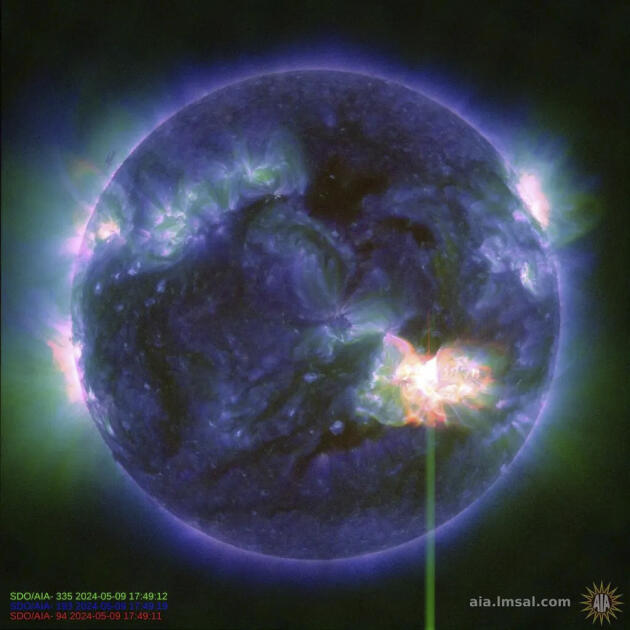The most powerful solar storm in more than two decades struck Earth on Friday, May 10, triggering spectacular celestial light shows in skies from Tasmania to Britain – and threatening possible disruptions to satellites and power grids as it persists into the weekend. The US National Oceanic and Atmospheric Administration issued a rare severe geomagnetic storm warning when a solar outburst reached Earth on Friday afternoon, hours sooner than anticipated. The effects were due to last through the weekend and possibly into next week.



The first of several coronal mass ejections (CMEs) – expulsions of plasma and magnetic fields from the Sun – came just after 4 pm GMT, according to the National Oceanic and Atmospheric Administration (NOAA)'s Space Weather Prediction Center.
It was later upgraded to an "extreme" geomagnetic storm – the first since the so-called "Halloween Storms" of October 2003 caused blackouts in Sweden and damaged power infrastructure in South Africa. More CMEs are expected to pummel the planet in the coming days.
Social media lit up with people posting pictures of auroras from northern Europe and Australasia. "Absolutely biblical skies in Tasmania at 4 am this morning. I'm leaving today and knew I could not pass up this opportunity," photographer Sean O'Riordan posted on X alongside a photo.
Authorities notified satellite operators, airlines and the power grid to take precautionary measures for potential disruptions caused by changes to Earth's magnetic field.

Unlike solar flares, which travel at the speed of light and reach Earth in around eight minutes, CMEs travel at a more sedate pace, with officials putting the current average at 800 kilometers per second.
They emanated from a massive sunspot cluster that is 17 times wider than our planet. The Sun is approaching the peak of an 11-year cycle that brings heightened activity.
'Go outside tonight and look'
Mathew Owens, a professor of space physics at the University of Reading, told Agence France-Presse that while the effects would be largely felt over the planet's northern and southern latitudes, how far they would extend would depend on the storm's final strength. "Go outside tonight and look would be my advice because if you see the aurora, it's quite a spectacular thing," he added. If people have eclipse glasses, they can also look for the sunspot cluster during the day.
In the United States, this could include places such as Northern California and Alabama, officials said. NOAA's Brent Gordon encouraged the public to try to capture the night sky with phone cameras even if they can't see auroras with their naked eyes. "Just go out your back door and take a picture with the newer cell phones and you'd be amazed at what you see in that picture versus what you see with your eyes."
Potential blackouts
Fluctuating magnetic fields associated with geomagnetic storms induce currents in long wires, including power lines, which can potentially lead to blackouts. Long pipelines can also become electrified, leading to engineering problems. Pigeons and other species that have internal biological compasses could also be affected. Pigeon handlers have noted a reduction in birds coming home during geomagnetic storms, according to NASA's Jet Propulsion Laboratory.
Officials said people should have the normal backup plans in place for power outages, such as having flashlights, batteries and radios at hand.
The most powerful geomagnetic storm in recorded history, known as the Carrington Event, occurred in September 1859, named after British astronomer Richard Carrington. Excess currents on telegraph lines at that time caused electrical shocks to technicians and even set some telegraph equipment ablaze.
Even when the storm is over, signals between GPS satellites and ground receivers could be scrambled or lost, according to NOAA. But there are so many navigation satellites that any outages should not last long, Steenburgh noted.



No serious threat to the astronauts aboard the ISS
The sun has produced strong solar flares since Wednesday, resulting in at least seven outbursts of plasma. Each eruption – known as a coronal mass ejection – can contain billions of tons of plasma and magnetic field from the sun's outer atmosphere, or corona. The flares seem to be associated with a sunspot that's 16 times the diameter of Earth, according to NOAA. It's all part of the solar activity that's ramping up as the sun approaches the peak of its 11-year cycle.
NASA said the storm posed no serious threat to the seven astronauts aboard the International Space Station. The biggest concern is the increased radiation levels, and the crew could move to a better-shielded part of the station if necessary, according to Steenburgh. Increased radiation also could threaten some of NASA's science satellites. Extremely sensitive instruments will be turned off, if necessary, to avoid damage, said Antti Pulkkinen, director of the space agency's heliophysics science division. Several sun-focused spacecraft are monitoring all the action. "This is exactly the kinds of things we want to observe," Pulkkinen said.